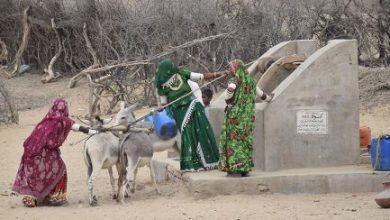Thar Desert After The Rain

The rains have once again gifted Thar a brief season of abundance. Its people, livestock, and wildlife rejoice in the greenery and flowing streams.
- Yet without meaningful governance, this fragile balance will not last. For now, Thar breathes easy. But the unchecked greed of a few continues to threaten the survival of many.
By Ali Nawaz Rahimoo
Monsoon rains may have revived Thar’s food basket, but the age-old problem of encroachment on grazing lands by powerful landlords still casts a shadow over the desert’s fragile prosperity. For much of Pakistan, the monsoon season brings chaos, urban flooding, collapsed infrastructure, and displacement. But for the resilient people of Thar, the rains remain a blessing, breathing life into the desert’s parched soil. Spanning 22,000 square kilometers, Tharparkar is the world’s sixth-largest desert. Despite its arid climate, it is unique as the only fertile desert in the world, where rainfall transforms its landscape into fields and pastures. At dawn, its golden dunes echo with the tinkling bells of cows, goats, and sheep, while peacocks unfurl their feathers. Migratory birds, falcons, rabbits, reptiles, and even endangered vultures thrive when rains return to the region.

 A Land of Culture and Harmony
A Land of Culture and Harmony
Thar’s cultural fabric is woven from Gujarati, Rajasthani, and Sindhi traditions, blending folk legends, spiritual heritage, and centuries-old practices. Despite being among the poorest of Pakistan’s 120 districts — ranking at the lowest end of the Human Development Index Thar remains an oasis of peace and religious harmony. According to the 1998 census, Muslims made up 64% of the population, while Hindus accounted for 36%, living side by side with remarkable tolerance. Over centuries, Thar has inspired artists, poets, and Sufi mystics including Shah Abdul Latif Bhittai, whose verses immortalized its beauty, resilience, and people.
 A Desert Transformed
A Desert Transformed
The recent nine-day spell of torrential rains has turned Thar’s barren expanse into a carpet of green. Hills and plains are now covered with shrubs and grass, while streams cascade down to dams and the Rann of Kachh, reshaping the desert into a picture-perfect landscape. Moderate to heavy showers lashed Mithi, Chachhro, Nagarparkar, Islamkot, Diplo, Kaloi, and surrounding villages, lifting the spirits of Tharis after prolonged dry spells. Each drop of rain carries the promise of survival. Peacocks often the first casualties of drought now dance in celebration. Farmers are sowing millet, beans, and vegetables, crops that sustain families, feed livestock, and bring modest surpluses for trade. The rains have also drawn thousands of visitors. From the Karoonjhar Hills and centuries-old Jain temples to Gaddi Bhit in Mithi, Thar’s picnic spots are teeming with tourists. A desert often synonymous with drought is suddenly alive with colour, water, and joy.
 A Season of Abundance
A Season of Abundance
For farmers like Beram, July mornings mean sowing millet and cluster beans with the narri, a traditional tube-like tool. “It is an environment-friendly method of cultivation,” he explains. Within months, fields will yield pearl millet, cluster beans, mung beans, moth beans, and vegetables such as melons, gourds, and tinda/Meha. Rain-fed ponds and reservoirs have been replenished, providing drinking and household water for up to four months. For herders, the abundance of grass offers relief from the perennial fodder shortage. “We will store it now for the dry months ahead,” says Dilpat, a cattle herder. For families like that of Mano, who migrated months earlier to Sindh’s barrage areas in search of fodder, the rains mean a chance to return home. “We will not have to migrate this season,” he says with relief.
 The Unequal Struggle
The Unequal Struggle
Yet prosperity in Thar is not equally shared. Encroachments on grazing lands by influential landlords continue to rob poor farmers and herders of their livelihoods. Since colonial times, laws prohibited large-scale cultivation in Thar, reserving vast stretches as grasslands for biodiversity and livestock. For every 10 acres of farmland, 100 acres were required to remain grazing land. Today, this balance is being openly violated. “Poor Tharis who do not own land depend entirely on grasslands to graze their cattle,” says Mustaque Ahmed, a social activist from Chachhro. “Encroachments threaten both their survival and Thar’s fragile ecology. The government must act before it’s too late.” Despite repeated complaints, the revenue department has failed to enforce the ban on cultivating grazing lands. Minor offenders face occasional action, but landlords with political connections operate with impunity.
 According to local activists, over half of Thar’s grazing lands have now been converted into farmland, depriving seven million livestock of fodder. This has not only disrupted livelihoods but also triggered recurring disputes, sometimes escalating into violent feuds.
According to local activists, over half of Thar’s grazing lands have now been converted into farmland, depriving seven million livestock of fodder. This has not only disrupted livelihoods but also triggered recurring disputes, sometimes escalating into violent feuds.
 A Fragile Balance
A Fragile Balance
The rains have once again gifted Thar a brief season of abundance. Its people, livestock, and wildlife rejoice in the greenery and flowing streams. Yet without meaningful governance, this fragile balance will not last. For now, Thar breathes easy. But the unchecked greed of a few continues to threaten the survival of many.
Read: Mental Health Crises Hit Sindh Deserts
____________________
 Ali Nawaz Rahimoo, based in Umerkot, Sindh is a social development professional. He can be contacted on anrahimoo@gmail.com
Ali Nawaz Rahimoo, based in Umerkot, Sindh is a social development professional. He can be contacted on anrahimoo@gmail.com




